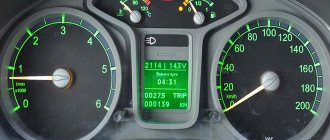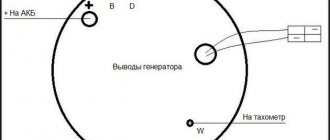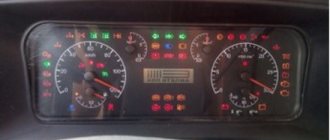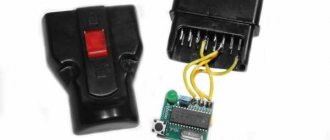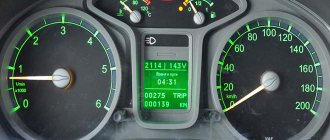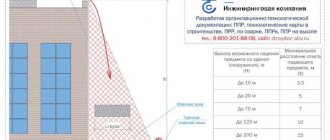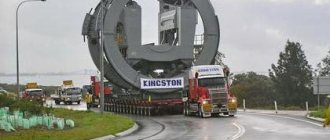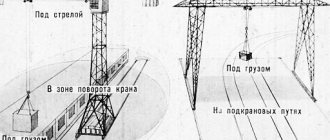Speedometer indicator coefficient
Speedometer indicator coefficient (SCI)
— numerical characteristic.
Ensures the accuracy of the electronic speedometer
within specified limits and is expressed in the number of impulses generated by the sensor per 1 km of distance traveled, denoted by the letter “k”.
On car 5320, during assembly, the speedometer was adjusted and the speedometer connecting elements were sealed.
The coefficient of the speedometer indicating device can be determined by two methods:
- direct measurement method;
- by the preliminary calculation method.
Direct measurement
The driver of the car at low speed (less than 10 km/h) drives a measured section of the road with a distance of 1 km or a distance multiple of 1000 m and, at the command of an assistant located at the final mark, stops the car. Note the number of pulses shown by the speedometer.
The PPP coefficient is calculated using the following formula:
K= 1000xP/L,
where L is the distance traveled by the car; P is the number of pulses shown by the speedometer.
For example, if the device showed 504 pulses over 100 meters of a car’s journey, then the CPPS should be set to 5040 (i.e. 504×10). Or, for example, if the device showed 99 pulses over 20 meters of the car’s path, then “k” should be set to 4950 (i.e. 99×50), etc.
In order to increase accuracy, the process of measuring the number of pulses can be repeated several times and then the arithmetic mean value of the PPP coefficient can be calculated.
Advance paynemt
According to this method, the value of the coefficient “k” is entered after performing a preliminary calculation in accordance with the formula:
k=(S/2·π·R)·i·n
where k is the number of input pulses per 1 km of run, or KPPS; S — vehicle mileage (standardized distance equal to 1 km); π is a constant (π = 3.14); R—car wheel radius, m; i- final drive gear ratio; n is the number of inductor teeth (6 or 8).
The meaning of coefficients for electronic speedometers
, obtained by calculation depending on various options for gear ratios and wheel radius for car 5320 are presented in Appendix B.
Appendix B. The value of programmable coefficients for electronic speedometers depending on various options for gear ratios and wheel radius for car 5320
| № | Gear ratio of final drive i g.p. | Tire designation | Static wheel radius Rk, m | Programmable coefficient F1000 for sensors | Gearbox type | |
| k=6 | k=8 | |||||
| 1 | 5,43 | 9.00R20 | 0,476 | 10899 | 1453 | |
| 10.00R20 | 0,488 | 10631 | 14175 | |||
| 10.00R20 | 0,505 | 10273 | 13697 | |||
| 11/70R22.5 | 0,447 | 11606 | 15475 | |||
| 2 | 5,94 | 9.00R20 | 0,476 | 11923 | 15897 | |
| 10.00R20 | 0,488 | 11629 | 15506 | |||
| 10.00R20 | 0,505 | 11238 | 14984 | ZF, 154 | ||
| 3 | 6,33 | 12.00R20 | 0,526 | 11498 | 15330 | |
| 4 | 6,53 | 9.00R20 | 0,476 | 13107 | 17476 | |
| 10.00R20 | 0,488 | 12785 | 17046 | |||
| 10.00R20 | 0,505 | 12354 | 16472 | |||
| 5 | 7,22 | 9.00R20 | 0,476 | 14492 | 19322 | |
| 10.00R20 | 0,488 | 14135 | 18847 | |||
| 11/70R22.5 | 0,447 | 15432 | 20576 | |||
| 6 | 4,01 | 245/70R19.5 | 0,389 | 9849 | 13132 | |
| 7 | 5,11 | 11/70R22.5 | 0,447 | 10922 | 14563 | ZF, 154 |
| 8 | 5,13 | 11/70R22.5 | 0,447 | 10965 | 14620 | |
| 9 | 5,08 | 11/70R22.5 | 0,447 | 10858 | 14477 | |
| 10 | 5,44 | 11/70R22.5 | 0,447 | 11627 | 15503 | |
| 11 | 7,22 | 9.00R-20(260-508R) 10.00-20(280-508R) | 0,495 0,507 | 13936 13606 | 18581 18141 | 14,141 |
| 12 | 6,53 | 9.00R-20(260-508R) 10.00-20(280-508R) | 0,495 0,507 | 12604 12305 | 16805 16407 | |
| 13 | 5,94 | 9.00R-20(260-508R) 10.00-20(280-508R) | 0,495 0,507 | 11465 11194 | 15287 14925 | |
| 14 | 5,4 | 9.00R-20(260-508R) 10.00-20(280-508R) | 0,495 0,507 | 10423 10176 | 13897 13568 | |
F1000 = 1000 i g.p k/2π Rk
i g.p - gear ratio of the main gear; Rк is the static radius of the wheel; k is the number of inductor teeth. For KIENZLE sensors k=6, for PA8089 k=8.
Very often, a novice tachograph master has to deal with this issue.
Because Very often, when installing a tachograph, you have to change the speed measurement components, the speed sensor and speedometer. But as a rule, new speedometers with a programmed K coefficient are installed to replace analog speedometers.
After installing the speedometer, the master can enter the speedometer programming mode by entering the PIN code from the secret menu and change this parameter. The PIN code for the speedometer is located under the rear sealing cover. Please note that on some speedometer models, this pin code from the manufacturer is glued to a small sticker that simply disappears over time for a number of reasons.
And so everything is fine if the speedometer is new or we took out the old speedometer and found there the same PIN code that makes it possible to change the K coefficient of the speedometer. But, what to do if, for example, there is no PIN code, it is lost, erased, or the speedometer does not have a programming function, the K coefficient is stitched into it by the manufacturer, for example, like on GAZelle panels and many others.
In fact, everything is simple, provided that we know what to do. We installed the tachograph , made all the connections, calibrated the tachograph, we know W of the tachograph, then we take the signal from contact B7 of the tachograph and apply it to the speedometer input, of course, due to the difference in the signal coefficients of the speedometer and tachograph, we will see discrepancies in the speed readings.
Fortunately, if we installed a digital tachograph with a programmed output B7, in this case, we can adjust the output coefficient of the speed signal to the speedometer according to the K coefficient of the speedometer programmed from the factory, which must be calculated.
And so let’s start calculating the K speedometer, using a programmed speedometer as a basis, but on the condition that we don’t know the password for it, and so we don’t know the coefficient K either.
To calculate the K speedometer, you need a tachograph programmer, which should be in the arsenal of every decent workshop; we will carry out our calculations using the TS-2010 tachograph programmer. So here I draw special attention to scammers: you cannot change the mileage in the speedometer using a tachograph programmer!
I will briefly describe our actions: in general, everything is simple as in school, we have a value that we do not know K of the speedometer , in order to calculate it we need to send a signal to the speedometer with known values of speed and coefficient K and we can only do this using a programmer . The formula by which we will then calculate everything on the calculator is:
And so we take the programmer and connect its output signal wire to the input of the speedometer signal wire, do not forget that the ground of the programmer and the speedometer must also be connected to one point, otherwise nothing will work. Why? that's another topic.
So we have everything connected, go to the Analog tachograph test mode, then speedometer test (the names of menu items in different programmers may vary, but I think you’ll figure it out)
Set the output signal parameters:
- To the programmer = 6000
- Programmer V = 50.0 km/h (speed)
- d = 10000 takes a long time to explain (in our case, the larger this parameter, the better, so as not to interrupt the test)
We press the Start button on the programmer and look at the speedometer needle, it begins to deflect, as can be seen in the figure, when a signal with the parameters we have specified is received, the speedometer needle deflects to a value of 61 km/h.
Take a calculator and start the calculation:
We receive and write down the result K speedometer = 4918
Next, we enter it into the programmer and perform this calculation at different speeds 20,50,80,110
After all our simple actions, we write this resulting coefficient into the parameters of the output signal of the B7 tachograph.
We get: our tachograph measures the signal from the speed sensor using its calculations, for example, the value of 10,000 imp. per km. further processes this signal and outputs it through the programmed output B7 to the speedometer, BUT with the values that we set 4918 as a result, everything is adequately displayed and everyone is happy. But don’t rush to rejoice because... after some time of operation of the vehicle. the client will definitely call you and report discrepancies between the tachograph mileage and the speedometer; this is due to the built-in error in the speedometer.
Manufacturers, when producing speedometers, deliberately include an error in them that underestimates the actual speed characteristics in accordance with GOST. Moreover, this error is linear, i.e. with increasing vehicle speed the error increases. If the error were not linear, then with a more qualitative and accurate measurement of the speedometer coefficient K using the above method, it would be possible to achieve a minimal discrepancy, but someone will say “we measured the movement of the speed needle by eye,” but no. Even if we install a new speedometer with a known pin code with which we entered the same coefficient K as in the tachograph, there will be a run-up on the speedometer, and from experience I can say that when measuring the K of the speedometer, taking into account the error (I mean the method described above) the discrepancies between the tachograph and speedometer are much smaller.
I would also like to note the category of speedometers interacting with a digital tachograph via the CAN bus, i.e. These speedometers also receive speed information from a digital tachograph, BUT they do not measure the input signal, it simply is not there. Speed information is simply transmitted by the tachograph to the speedometer via the CAN bus. When using a combination of speed sensor - digital tachograph - CAN speedometer, the difference in the readings of the total distance traveled will be zero. The CAN speedometer is, roughly speaking, just an indicator; it does not have its own mechanism for calculating speed. These speedometers are installed in European trucks; in new MAZ KAMAZ models, calibrating them is not only not necessary but not possible. I still advise you to read what a CAN bus is.
Notes:
- As a rule, at speedometer manufacturing plants, if we took a panel from a GAZelle, the K coefficient is rounded to hundredths. For example, if during measurements we got the speedometer K value = 2548, then it would be worth rounding it up to 2500.
- Connecting a speedometer with different coefficients is possible provided that there is a programmed output in the digital tachograph B7, for example, the digital tachograph VDO1381 does not have this output, but the SE5000 does.
Standard K values programmed from the factory in programmable speedometers:
- 811.3802 140mm 12V: 4992
- 81.3802 140mm 24V: 4992
- 87.3802 100mm 24V: 1248
In our experience, we used a 140mm 12V 811.3802 speedometer with a factory coefficient K = 4992, in our measurement we got the speedometer K = 4918, as you can see we almost got it and this is with one measurement, take measurements at least three times and you will be happy.
Speedometer reset | Odometer
Speedometer twist without mileage limit
Want to know how much it will cost to reset the speedometer on your car?
You just need to call our manager on +7 (499) 344-02-74 or select your car brand
From time to time, motorists are faced with a difficult task - resetting the speedometer. This could be due to many factors. Corrective measures must be taken in cases where the readings on the speedometer begin to be inconsistent with reality. Most likely, this was caused by a glitch. Only professionals can allow themselves to increase or rewind the mileage of a car, so in the absence of special knowledge and experience, it is best to contact a specialized institution.
Many people believe that resetting the speedometer is only necessary in cases where the driver wants to hide data about the car’s mileage. But there are still situations when this procedure simply cannot be avoided. The odometer readings change. This is done when replacing any parts, for example, the same odometer or engine.
If, upon installation, the new odometer shows zero mileage, it must be adjusted upward. If the mileage is too high, if the installed odometer has already been used, the readings are adjusted downward.
Electronic speedometers are more popular today, despite their expensive price compared to mechanical ones. In specialized salons, professionals have a whole arsenal of special devices to reset the speedometer.
In order to reset the readings, specialists use devices such as a programmer, scanner, adapter and other tricky devices. This process is quite complex, since data must be deleted both from the on-board computer and from the car’s microprocessor memory. Its location in the car may vary. It contains information about mileage and regular inspections at service centers.
In order to reset the speedometer, experts use a method called reprogramming. Only high-quality equipment can not harm the performance of other instruments located on the instrument panel. Today, centers specializing in this type of work use several technologies to reset readings. One of these methods is detachable reprogramming, that is, through connectors. It can only be applied if there is an access protocol as well as a memory encoding. An alternative to this method could be a new microcircuit, after installation of which the indicators can be changed repeatedly. Another way is to twist using an external generator and receiving signals. In this case, specialists must decrypt the data in detail.
If you have any questions, you can ask them to the “odometer service” specialists by phone. Those wishing to place an order can fill out the order form or place an order by phone.
Address: Moscow, Central Administrative District Pestovsky Lane, 2с1. Directions Phone: +7 (499) 344-02-74
Don't trust the numbers on the meter
Are you planning to buy a used car? Did you find an inexpensive, fresh, unbeaten one that a pensioner drove to the dacha? Make no mistake - the car was carefully cleaned up before sale, and the mileage was trivially adjusted. What would pre-sale preparation be without this?
Twisting the odometer, trip meter, is now called fashionably - speedometer correction. Twenty dollars and whatever mileage you want. When electronic odometers first appeared, many believed that mileage could not be changed in any way. Old mechanical counters with wheels and numbers are quite easy to adjust. The design of such a device is very primitive: inside it there is an axis and a number of gears that move the numbers. By tightening the counter gears, you can set any mileage.
